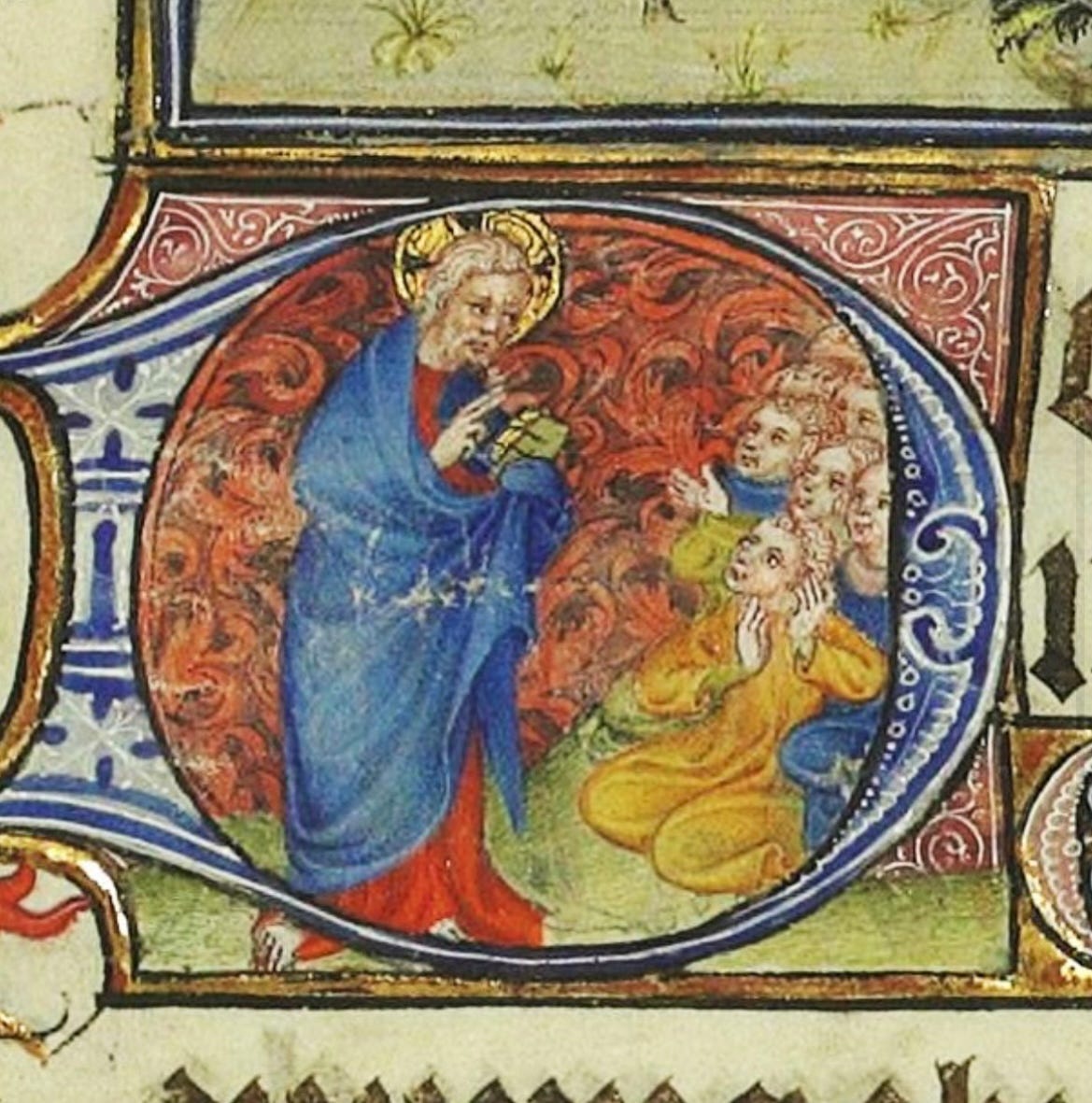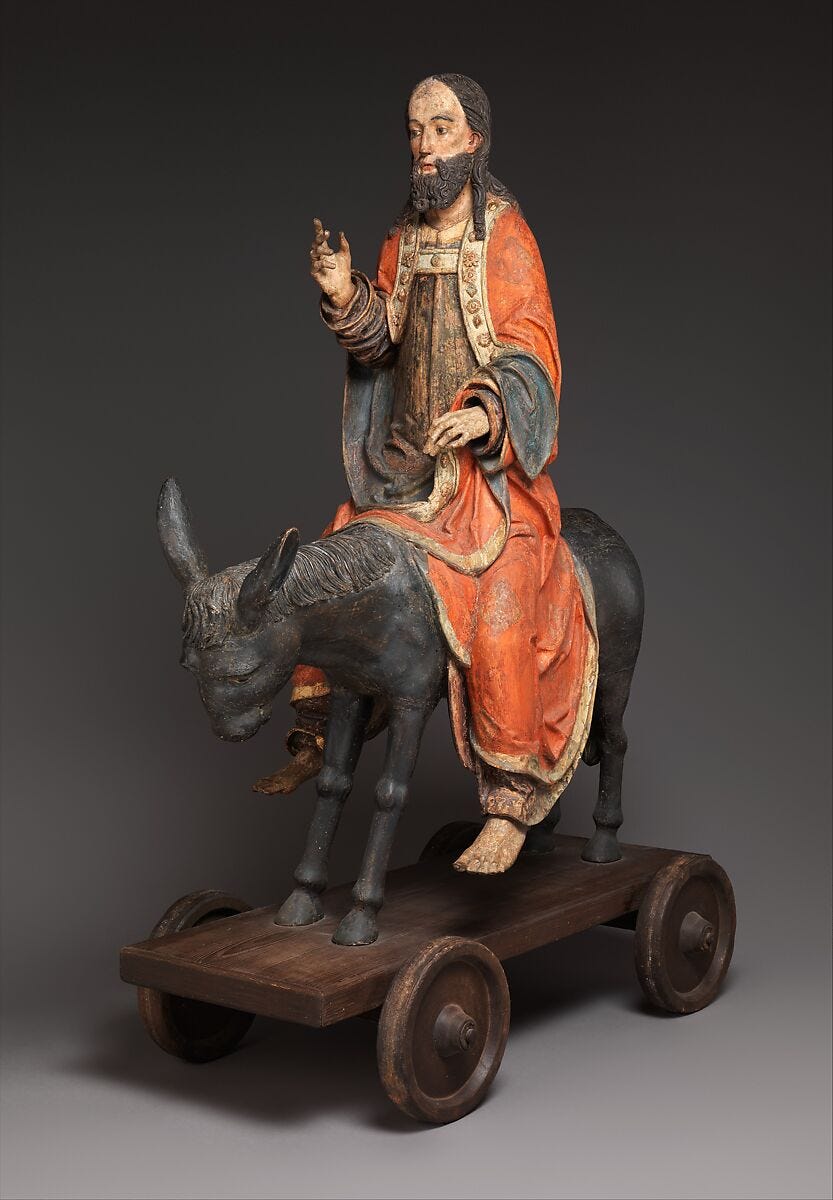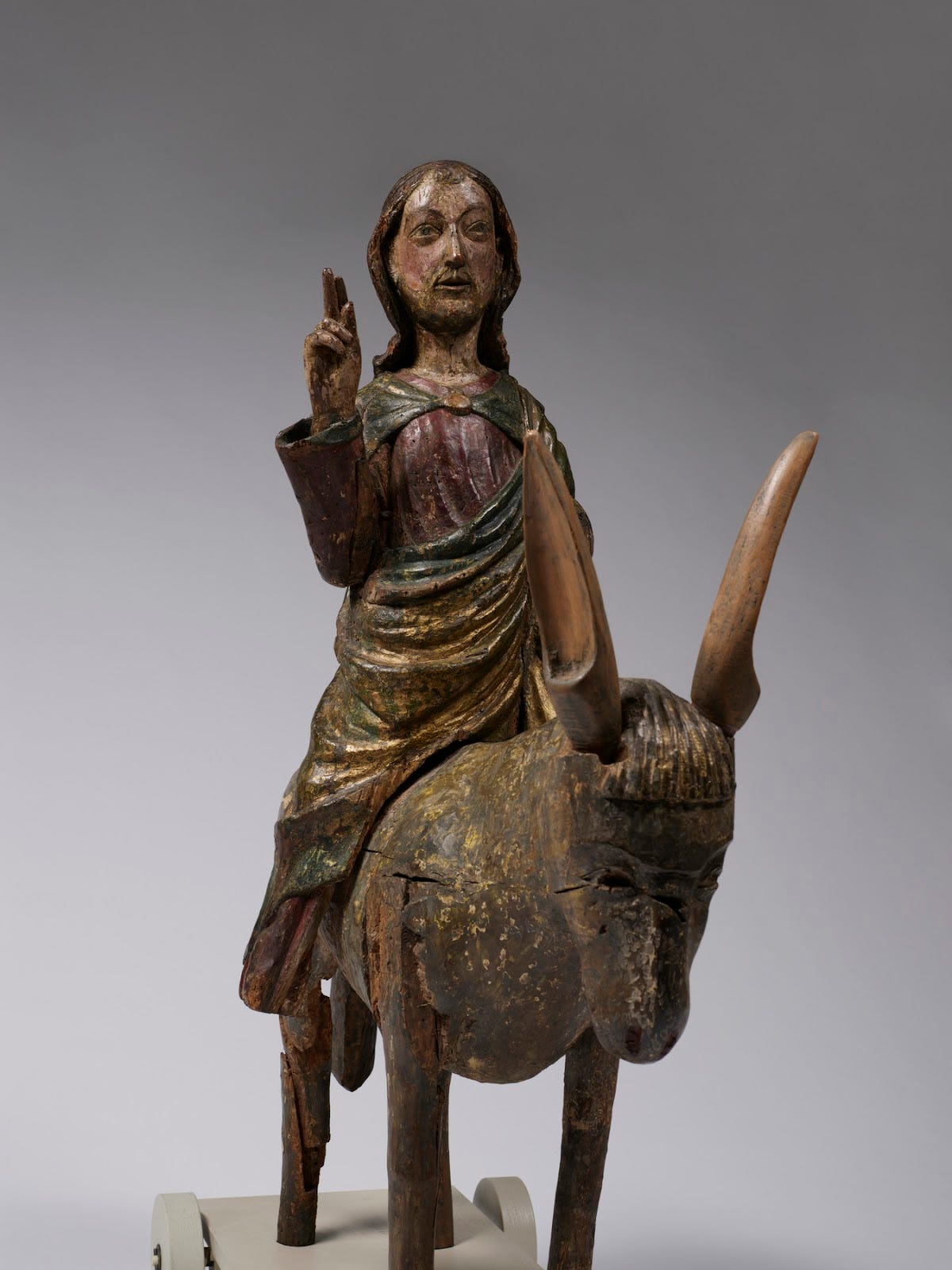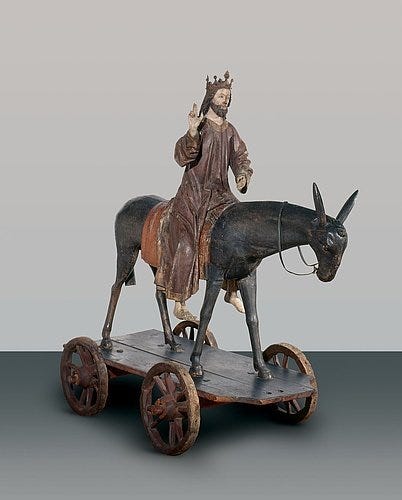
Colorful flowers and birds surround this exuberant Palm Sunday miniature, which depicts Christ’s entry into Jerusalem. Every inch of the page is filled with fruitful fronds and flowers, but Christ still draws our attention as he rides into Jerusalem in the center of the page. His solid, bright blue cloak and dignified, erect figure stand out amidst the curling vegetation and swirling background. Even monkeys turn towards him, holding heralds and reminding us that all creation sings God’s praise. An angel watches on from the corner of the page, contemplating the mystery.
This illumination presents Jesus as the Word Incarnate, the King who comes to restore all of creation. As such, the artist not only illustrates palms but also local fauna and flowers. In many countries, Palm Sunday has also been called “Pussy-willow Sunday” and “Flower Sunday,” as most churches throughout Christian history have not used palms, but instead local flowers and trees as part of their processions.1
The entry into Jerusalem is the beginning of Christ’s Passion and a prefigurement of his Victorious death, through which he opens the gates of the heavenly Jerusalem.
In the miniature, Hebrew boys celebrate his coming, waving palm branches in the trees and laying their garments at his feet, welcoming him to Jerusalem. This tradition is reflected in antiphons for the Palm Sunday procession in both Eastern and Western liturgies.
The children of the Hebrews, carrying palms and olive-branches, went forth to meet the Lord, crying out and saying, Hosanna in the highest! (Antiphon 1)
The children of the Hebrews spread in the way their clothes and garments, and cried, saying, Hosanna to the Son of David: Blessed is he that cometh in the name of the Lord! (Antiphon 2)2
The artist accentuates this theme in the small image painted in the initial. It features an image of Christ preaching to the children, a reminder that we must become like little little children in faith to enter the kingdom of heaven.
Christ enters Jerusalem holding the Word out in front of him, pointing to the fact that he is the Word and the fulfillment of the Old Testament. He blesses the people of the city, who spread their garments before him and wave palm branches symbolizing triumph and peace. Jerusalem is represented here by a castle, for Christ enters as a King, triumphant and praised by his people.
In many ways, Jesus’s entry mimics that of an emperor returning from conquest, and yet it is not the same, for his kingdom is not of this world. As such he does not enter on a warhorse, but on a donkey, as David did, fulfilling the prophecies.
Rejoice greatly, O Daughter of Zion! Shout, Daughter of Jerusalem! See, your king comes to you, righteous and having salvation, gentle and riding on a donkey, on a colt, the foal of a donkey. I will take away the chariots from Ephraim and the war-horses from Jerusalem, and the battle bow will be broken. He will proclaim peace to the nations. His rule will extend from sea to sea and from the river to the ends of the earth. As for you also, because of the blood of my covenant with you, I will set your captives free from the waterless pit. (Zechariah 9:9-12)
The last part of the prophecy, which points to Christ’s sacrificial death and his descent into Hades, also appears in this miniature. The way Christ and his apostles seem to emerge from a cave resembles images of the Harrowing of Hell, when Christ went down to the realm of the dead to rescue the righteous and lead them to Paradise. In the miniature, Christ’s apostles follow him into Jerusalem, Peter the first among them. Some hold palms which point to their own martyrdom; they will eventually walk their own passion and follow Christ into the Heavenly Jerusalem.
Despite the joyful entry on Palm Sunday, we know Christ still must undergo his Passion before rising victoriously. It is not a coincidence that a tree sprouts between Jesus and the city gates. When Jesus entered Jerusalem, the Cross still stood in his path.
This lively miniature reflects the joy of the Palm Sunday blessing and procession, which precede the sorrowful Mass in which the Passion is read. The procession is the beginning of Holy Week and an ancient Christian tradition. In this passage, the nun Egeria recounts one from the fourth century:
As the eleventh hour (our 5:00 P.M .) draws near, that particular passage from Scriptures is read in which the children, bearing palms and branches, came forth to meet the Lord, saying: ” Blessed is He Who comes in the name of the Lord!” (Mt. 21 :9). The Bishop and the people rise immediately and walk down from the top of the Mount of Olives, responding continually: ‘Blessed is He Who comes in the name of the Lord!’ to the hymns and antiphons. All the children who are present bear branches, some carrying palms, others olive branches. And the Bishop is led in the same manner as the Lord was led (riding on a donkey).” (Egeria, Diary of a Pilgrimage, 31).
When this sumptuous manuscript was made in the 1400’s, these processions often featured a Palmesel, a wooden statue of Christ riding upon a donkey. The blessing of the palms would often begin at a church or monastery outside of the walls of the city, and young boys would carry the statue of Christ back into the walls of the city, singing hymns of praise, as the congregation followed. In these statues, Christ usually wears kingly robes, and is depicted with “an air of quiet majesty.” The use of Palmesels is first recorded by St. Ulrich of Augsburg in the tenth century:
On that day at dawn [Ulrich] used to come to the church of St. Afra, if he had not already spent the night there. He would sing the mass of Holy Trinity and bless the palm branches and various other foliage. The with the gospel book, and crosses and banners, and with the image of the lord seated on an ass [cum effigie sedentis domini super asinum] with the clergy and a multitude of people carrying palm branches in their hands, and with chants composed in honour of that same day, he proceeded with great splendor to the hill called Perlach. There with everything beautifully done, the choir of canons came to meet him, as well as the citizens, who had remained in the city, and those from the surrounding towns, who wanted to join them there in imitating the humility of the children and the rest of the people who [long ago] strewed the way of the Lord with palm branches and their own clothes. After this, the holy man preached to everyone a most suitable sermon about the Lord's passion, often weeping himself and by his tears causing many others to weep. When his sermon was finished, everyone came to the Cathedral Church praising God and there celebrated mass with him. Afterwards they all went home.
After the Reformation, the Palmesel was suppressed, and many were destroyed; however hundreds still survive. Many are located in museums, but there are also some still in use in Palm Sunday processions.
When we participate in physical traditions such as this, it helps our bodies to inform our souls of the spiritual realities which we celebrate. In Saint Andrew of Crete’s sermon, which is included in the Divine Office for Palm Sunday, he reminds us that we also must allow the mystery of Palm Sunday to transform our lives.3
Let us run to accompany him as he hastens toward his passion, and imitate those who met him then, not only by covering his path with garments, olive branches or palms, but by doing all we can to prostrate ourselves before him by being humble and by trying to live as he would wish. Then we shall be able to receive the Word at his coming, and God, whom no limits can contain, will be within us…
So let us spread before his feet, not garments or soulless olive branches, which delight the eye for a few hours and then wither, but ourselves, clothed in his grace, or rather, clothed completely in him. We who have been baptized into Christ must ourselves be the garments that we spread before him. Now that the crimson stains of our sins have been washed away in the saving waters of baptism and we have become white as pure wool, let us present the conqueror of death, not with mere branches of palms but with the real rewards of his victory. Let our souls take the place of the welcoming branches as we join today in the children's holy song: Blessed is he who comes in the name of the Lord. Blessed is the king of Israel.
Most countries could not import palms as we do today.
Antiphon 1.
Pueri Hebræorum portantes ramos olivarum, obviaverunt Domino, clamantes, et dicentes: Hosanna in excelsis.
Antiphon 2.
Pueri Hebræorum vestimenta prosternebant in via, et clamabant, dicentes: Hosanna Filio David: benedictus, qui venit in nomine Domini.
https://www.crossroadsinitiative.com/media/articles/palmsundayhecomesinhumility/












The 15th Century German wooden statue is absolutely astonishing.
Wonderful! I love the illumination of Christ preaching to the children. And I say bring back the Palmesel!